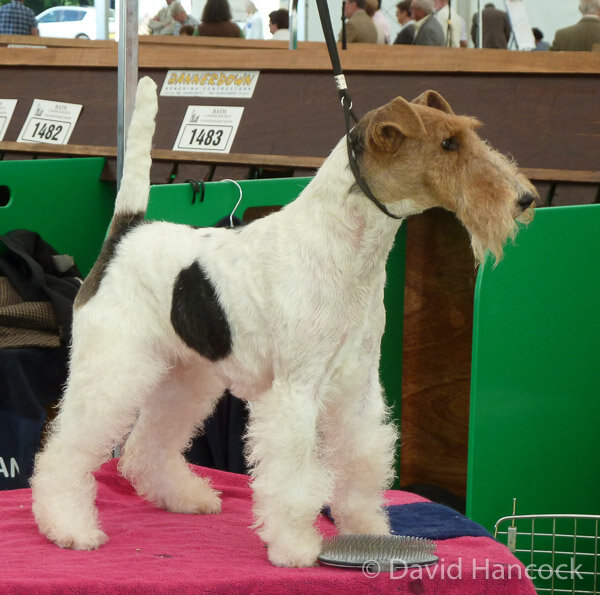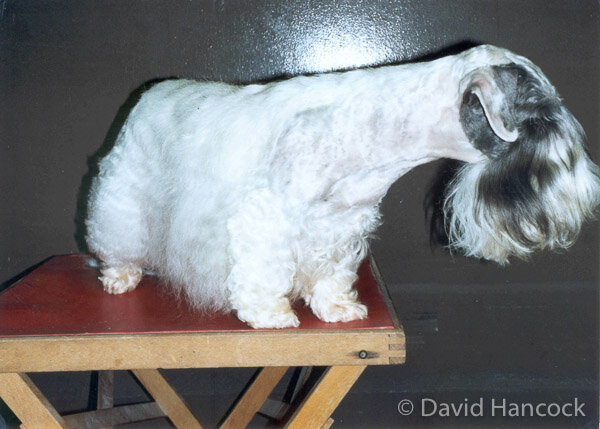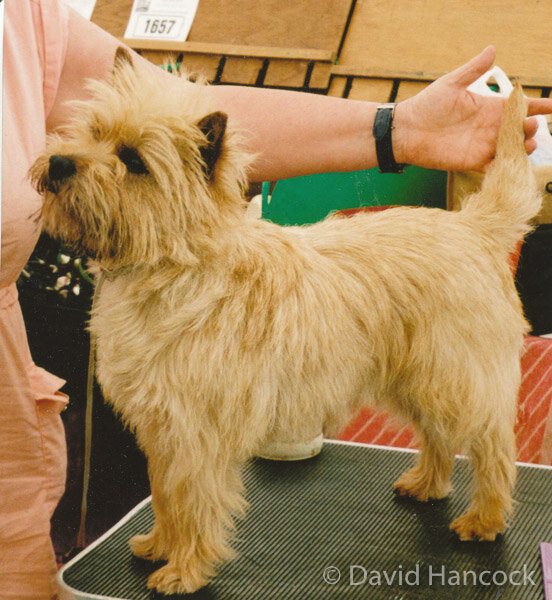1145
SQUARING UP TO TERRIERS
By David Hancock
“The Terrier Group: The common physical features are a robust and tightly-knit frame, well-muscled, small-to-medium in size, with the head rather long, without any dome, the ears small, triangular and usually folded over to the fore. Coat is mainly rough with a dense soft undercoat, protective eyebrows and no featherings. The tail is usually docked but when of natural length is fairly short. Such breeds as are still sent to earth are usually short-legged. The cubist effect of square bodies and rectangular heads is due to a temporary modern phase of fashion and does not represent a true family characteristic.” From Dogs in Britain by Clifford LB Hubbard, MacMillan & Co., 1948.
Those words apply more and more each year as the showmen mould our famous terrier breeds to suit, not the terrier function, but the show ring preference. Short-backed terriers lack flexibility, heavy heads unbalance the dog, too short a leg inhibits versatility across the sporting field. We bred terriers to be highly proficient killers of ground vermin and now we expect them to ignore every cat and squirrel that crosses their path. We bred them to possess stamina, spirit and tenacity, yet some breeders keep them in small cages for much of their lives. Their purpose never demanded exaggeration of any kind, but now we breed them with excessive overcoats, needlessly short legs and elongated backs. We overlook the fact that the working anatomy is nearly always the healthiest one. Terriers are a very special group of dogs and long may they be here to gladden our hearts with their modest needs, irrepressible energy, sheer pluckiness and very straightforward attitude to life.
In 1896, in his preface to the first edition of his ‘A History and Description of the Modern Dogs of Great Britain and Ireland: The Terriers’, Rawdon Lee wrote: I have endeavoured to give particulars as to their working qualifications and their general character, as well as their so-called “show points”; and my desire to prevent, if possible, a useful race of dog from degenerating into a ladies’ pet and a pampered creature, only able to earn his owner gold on the show bench, is my reason for treating so fully of him as he is concerned in that sphere which Nature intended him to occupy.’ I wish to continue that ethos; terriers often make good ladies’ pets and the show bench has saved some terrier breeds from oblivion, but whatever their role, terriers deserve to be perpetuated in their authentic functional form. That truly is as Rawdon Lee so picturesquely put it ‘that sphere which Nature intended him to occupy’.
In his Field Sports of 1760, terriers are described by William Daniel as being of two sorts, one of them rough, short-legged, long backed and very strong, usually black or light tan colour, mixed with white. The other was said to be smooth-haired and more pleasingly formed, with a shorter body and a more athletic appearance, usually reddish-brown or black with tan legs. Prototypes of subsequent breeds are hinted at here. French and German writers of previous centuries have made reference to dogs functioning as terriers, not just Dachshund types but Pinschers and Schnauzers too. We may have captured the terrier breed market but not the terrier function. But the squared-off, cubist look has crept into these German breeds too. It is vital that wherever terrier breeds come from they appear in the terrier mould and not in some show-ring shape.
If you look at the Kennel Club's list of terrier breeds in 1908, you will notice that it contains just 16 breeds, unlike the nearly 30 listed today. The more recently listed embrace the Australian, Glen of Imaal, Lakeland, Norfolk, Norwich, Parson Russell, Cesky, Staffordshire Bull Terrier and the German Hunt Terrier. Still awaiting recognition here, we have diverse types like the Japanese, Brazilian, Patterdale, Plummer and Sporting Lucas Terriers. But whatever the origin, the nomenclature or the literature behind the terrier type, this group of dogs deserve to be perpetuated as terriers not some exhibitionist’s design, unrelated to any function.
I have long argued for a return, especially in the show dogs with a working origin, to their functional form: a build which would allow them to perform in the field, even if they are not required to; traditional head shapes not fad-induced ones; good forward extension not restricted reach; weatherproof coats not fluffy woolly ones and, in particular, for the encouragement of their sporting instincts. Cubism is an art form, breeding terriers to fit some entirely artificial template ruins them; kennel clubs claiming that ‘the improvement of dogs’ is their mission need to square up to their responsibilities.











